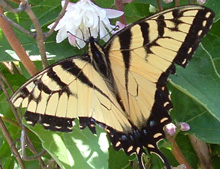 | Thursday, June 15, 2006 |
|
Thursday, June 15 1:30 p.m. Experimental Astrophysics Seminar - Dark Side (WH-6W) (NOTE DATE, TIME, LOCATION) Speaker: C. Stubbs, Harvard University Title: Calibration of LSST and Pan-STARRS with a Tunable Laser and a Calibrated Photodiode 2:30 p.m. Theoretical Physics Seminar - Curia II Speaker: C. Aubin, Columbia University Title: Muon g - 2: Reclaiming the Theoretical Calculation of the Leading QCD Contribution 3:30 p.m. DIRECTOR'S COFFEE BREAK - 2nd Flr X-Over 4:00 p.m. Accelerator Physics and Technology Seminar - Curia II Speaker: V. Lebedev, Fermilab Title: Coherent Instabilities at the FNAL Booster
Friday, June 16 Click here for a full calendar with links to additional information. |
|
Extended Forecast |
Secon Level 3 |
|
Thursday, June 15 -Southwestern Chicken Tortilla -Philly Style Cheese Steak -Chicken Pot Pie -Tomato Basil Chicken Parmesan -Southwestern Turkey Wrap -4 Cheese Pizza -Marinated Grilled Chicken Caesar Salads |
|
Thursday, June 15
Chez Leon Menu |
| Fermilab Today is online at: http://www.fnal.gov/today/ Send comments and suggestions to today@fnal.gov Fermilab Today archive Hurricane Relief Page Fermilab Today PDF Version Fermilab Result of the Week archive Fermilab Safety Tip of the Week archive Linear Collider News archive Fermilab Today classifieds Subscribe/Unsubscribe to |
|
Archaeology 2.0
| |
|
A century ago, Guiliano Pelfer's quest to explain the rise of the first European cities might have seen him leading an excavation in the Italian countryside. Today, his search is likely to lead him to a much less glamorous location-the server room down the hall.
Goodbye, Indiana Jones. Hello, IBM.
In addition to digging up artifacts and poring over ancient texts, today's archaeologists may draw on knowledge from dozens of scientific fields to create complex computer models of ancient societies. Pelfer and colleagues at the University of Florence and Italy's National Institute of Nuclear Physics in Catania are developing a grid application for the EGEE infrastructure called the ArchaeoGRID, which will bring all that knowledge together and link it with advanced computing resources.
|
|
New York Times, June 14, 2006: Graphic: Trolling for Cosmic Particles An international group of scientists is building a new kind of telescope at the bottom of the Mediterranean Sea near the east coast of France. To be completed in 2007, it will detect light generated by neutrinos, the high-energy cosmic particles that pass directly through the Earth. See graphic |
| Avoiding a breakup | ||
| ||
|
There is evidence for a new type of particle reaction at CDF. Most reactions at the Tevatron occur when a colliding proton and antiproton break apart into quarks in order to produce new particles. In this reaction the proton and antiproton actually remain intact, glancing off each other in a process which creates two high energy photons and nothing else. Only three events have been detected, but the background is predicted to be at most 0.2 events. These events are easy to identify because only two particles are created, compared to the huge number of particles in a typical reaction.
In the process of validating their measurement, CDF physicsists were able to observe another never-before-seen physics process at a hadron collider. Sixteen events were found which are consistent with the very accurate prediction that photons traveling with the proton and antiproton will interact to produce only an electron-positron pair without breaking up the proton and antiproton. Since the backgrounds to this process are similar to the two-photon reaction, this finding provides added confidence in the two-photon analysis. The search for this unusual two-photon process began in 2001, when CDF physicists explored the possibility that the Higgs boson could be produced by a similar process. Theoretically the Higgs field fills the vacuum, and it should be possible to "excite the vacuum" into a real Higgs particle in a glancing collision of a proton and antiproton. Theorists had tried to estimate the probability of this happening, but there was a very wide range in their predictions. The two-photon process measured at CDF is produced the same way as the Higgs and becomes a standard candle to predict the probability of its production. A theory group from Durham University calculates that there should be only about one such clean two-photon event in a trillion Tevatron collisions. The three events found by CDF agree with this prediction. This means that the similar process by which the elusive Higgs boson can be produced must also happen, and could be measured at the LHC, providing measurements of the Higgs boson's mass, spin and other properties. | ||
| ||
| Result of the Week Archive
|
|
June 13 -14 - Two stores provided 20 hours and 35 minutes of luminosity - TeV separator's wrong polarity distorts store luminosity - D0 powers down solenoid for calibration - CDF's silicon detector off
Read the Current Accelerator Update
|
|
Say Goodbye to Dr Foxen Today and tomorrow, from 9 a.m. to 3 p.m., there will be an open house in the medical office for people who wish to say goodbye to Dr. John Foxen.
Volunteer cleanup today
DASTOW set for June 22
Blood drive sign-up
Housing Assignments for Fall 2006 and Spring 2007 |




